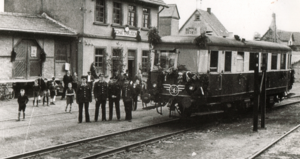WMW VT 2
| WMW VT 2 | |
|---|---|
|
T2 1951 in Schatthausen
|
|
| Numbering: |
WMW VT2 BHM VT2 |
| Number: | 1 |
| Manufacturer: | Dessau wagon factory |
| Year of construction (s): | 1939 |
| Retirement: | 1972 |
| Axis formula : | AA |
| Gauge : | 1435 mm ( standard gauge ) |
| Length over buffers: | 13,470 mm |
| Total wheelbase: | 7,000 mm |
| Empty mass: | 18,900 kg |
| Service mass: | 23,100 kg |
| Top speed: | 75 km / h |
| Installed capacity: | 2 × 70 kW (2 × 95 PS) |
| Wheel diameter: | 900 mm |
| Motor type: | 2 × Daimler-Benz OM 67 |
| Motor type: | Six-cylinder four-stroke diesel engine |
| Rated speed: | 2,000 rpm |
| Power transmission: | mechanical with 2 Mylius gears |
| Train brake: | Indirect brake , handbrake |
| Seats: | 56 |
| Classes : | 3. |
The railcars WMW VT2 was a two-axle railcar of the German railway operating company . It was procured in 1939 by the Dessau wagon factory in Dessau and was mainly used on the Wiesloch – Meckesheim / Waldangelloch railway line . It was in operation until 1972 and is no longer available today.
History and commitment
WMW VT 2
The railcar was one of a series of five two-axle diesel railcars that were procured by DEBG to streamline operations on various private railways. The railcar was used as a towing vehicle on the Wiesloch – Meckesheim / Waldangelloch route.
In the 1940s, when there were no precise operational data, the railcar was used on the Kraichtalbahn .
After 1946 the railcar was again stationed in Wiesloch and was only used on this route for the following time. In 1951 he was the main actor in the celebrations for the 50th track anniversary.
SWEG VT 2
In 1963 the route and the railcar became the property of the Süddeutsche Eisenbahn-Gesellschaft . He kept his name there. 1972 is considered his year of retirement. In 1974 it was sold to a scrap dealer and scrapped there.
Constructive features
The data of the railcar with the serial number 3216 are very similar to the railcars Achertalbahn T 281 and GHWE No. 61 , the car body it differs from these two models by the bevelling of the front section, as it was carried out on the RAG VT 01 .
The underframe and the box frame were made of lightweight frame construction and consisted of electrically welded structural steel profiles. The outside of the car body was clad with sheet metal 1.5 millimeters thick. The interior was divided into the passenger compartment and the two entry areas with a driver's cab. The passenger compartment consisted of two compartments of roughly the same size with a central aisle, these were divided by partitions. They were separated from the entry areas by partition walls and revolving doors. The floor was made of pine wood covered with linoleum. The machine system could be serviced via flaps in the floor.
The machinery consisted of a six-cylinder four-stroke diesel engine of the type Daimler-Benz OM 67, which was coupled with the Mylius transmission . The car body was heated by the cooling water from the diesel engines. This heating system enabled the diesel engine to be preheated after a long period of inactivity.
Originally the paintwork of the vehicle was the same as that of the Deutsche Reichsbahn : the roofs were painted aluminum, the underframes black, the upper part of the box between the windows ivory and the lower part dark red. After the main inspection, the railcar received the usual DEBG color combination in signal red with several horizontal white decorative stripes.
literature
- Meinhard Döpner: The Deutsche Eisenbahn Betriebs-Gesellschaft AG . In: Verlag Zeit und Eisenbahn . Lokrundschau Verlag GmbH, Gülzow 2002, ISBN 3-931647-13-7 .
- Gerd Wolff, Hans-Dieter Menges: German small and private railways . tape 2 : bathing . EK-Verlag, Freiburg 1992, ISBN 3-88255-653-6 .
Web links
Individual evidence
- ↑ a b c Meinhard Döpner: The German railway operating company AG . In: Verlag Zeit und Eisenbahn . Lokrundschau Verlag GmbH, Gülzow 2002, ISBN 3-931647-13-7 , p. 154 .
- ↑ Newspaper article about the 50th anniversary of the route in Wiesloch
- ↑ photo of VT2 the route anniversary in Dielheim .
- ↑ Photo of the VT2 at the track anniversary in Baiertal .
- ↑ a b Photo of the VT2 after its retirement in the possession of the scrap dealer.
- ↑ Wolfgang Theurich: From old archives , in: Eisenbahn-Magazin 4/95, p. 22.
